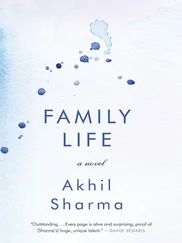Deborah Chambers - A Sociology of Family Life
Здесь есть возможность читать онлайн «Deborah Chambers - A Sociology of Family Life» — ознакомительный отрывок электронной книги совершенно бесплатно, а после прочтения отрывка купить полную версию. В некоторых случаях можно слушать аудио, скачать через торрент в формате fb2 и присутствует краткое содержание. Жанр: unrecognised, на английском языке. Описание произведения, (предисловие) а так же отзывы посетителей доступны на портале библиотеки ЛибКат.
- Название:A Sociology of Family Life
- Автор:
- Жанр:
- Год:неизвестен
- ISBN:нет данных
- Рейтинг книги:3 / 5. Голосов: 1
-
Избранное:Добавить в избранное
- Отзывы:
-
Ваша оценка:
- 60
- 1
- 2
- 3
- 4
- 5
A Sociology of Family Life: краткое содержание, описание и аннотация
Предлагаем к чтению аннотацию, описание, краткое содержание или предисловие (зависит от того, что написал сам автор книги «A Sociology of Family Life»). Если вы не нашли необходимую информацию о книге — напишите в комментариях, мы постараемся отыскать её.
A Sociology of Family Life With a global focus, and blending theory with real-life examples, this insightful and engaging book will remain indispensable to students across the social sciences.
A Sociology of Family Life — читать онлайн ознакомительный отрывок
Ниже представлен текст книги, разбитый по страницам. Система сохранения места последней прочитанной страницы, позволяет с удобством читать онлайн бесплатно книгу «A Sociology of Family Life», без необходимости каждый раз заново искать на чём Вы остановились. Поставьте закладку, и сможете в любой момент перейти на страницу, на которой закончили чтение.
Интервал:
Закладка:
The first central aim of this book is to document and analyse the growing diversity in personal and family life, while assessing the complex range of institutional constraints and freedoms that influence or shape these relationships. A growing public recognition of family diversity has triggered alarm among certain politicians, religious leaders, academics and journalists. The welfare of children and elderly relatives is viewed as a major issue in an era characterized by heavy employment commitments among family members, and, conversely, low pay or unemployment. Complex forms of commitment and care are being experienced by parents and wider kin at a time when governments in many countries are reducing social welfare provisions. Public debate about ‘good’ and ‘bad’ parenting has been fuelled by anxieties over collapsing moral standards caused by the decline of ‘proper’ family values. Moral panics about ‘family decline’ expressed by governments, the media and religious bodies are regularly accompanied by calls to return to the superior values of some past golden age of family life. Even though it is just one of many diverse living arrangements, the nuclear family model remains a powerful icon of tradition and stability, often perceived as an antidote to today’s social problems. However, as the following chapters show, upholding one version of family life as a model – white, heterosexual, middle class – not only obstructs knowledge about how families actually live. It can have negative consequences for individuals and families that diverge from this ideal. Family diversity is therefore a key theme within this book.
A second, related theme is intersectionality . This involves the study of the intersections of gender, sexuality, social class, race and ethnicity to assess how these social factors frame personal and family life. Intersectional approaches identify patterns of domination involving interlinked modes of oppression (Collins and Bilge 2016). Intersectionality enables scholars to scrutinize power disparities in private and public spheres that operate as forms of social stratification and inequality. Applying intersectionality perspectives to the analysis of changing family life allows scholars to spotlight social inequities, privilege and oppression as part of a critical theoretical perspective on families. Since the millennium, critical approaches have been used to frame analyses of family life to ensure that they are inclusive and relevant. As Few-Demo and Allen state:
Gender, feminist, and intersectional approaches offer critical analyses of how women, men, and children in different kinds of families experience privilege and marginalization in private and public contexts based on their gender, race, social class, sexual and gender orientations, nationality, among other forms of stratification. (Few-Demo and Allen 2020:326)
The push for legalized marriage equality for same-sex couples, Black Lives Matter and the Me Too movement are among high-profile political and social efforts aimed at securing rights and freedoms for marginalized groups (Few-Demo and Allen 2020). The growing visibility of diverse family structures, individual identities and changes in gender roles within both public and domestic spheres has transformed public conversations about intimacy and personal relations (Coontz 2016). Gender, sexuality, social class, race and ethnicity affect power relations in private and public domains, and affect families’ access to material resources. They also influence how families navigate oppressions such as poverty and discrimination. Scholars examine the interconnections between family life and stratified social systems that normalize inequalities of race, gender, sexuality and class which encompass social systems and institutions that determine who is granted access to welfare, education and health resources. Research evidence on the effects of the Covid-19 crisis reveals that the pandemic has exacerbated social inequalities across multiple spheres of family life, such as employment and home life, with a spike in domestic violence and an increased burden on women’s domestic and caring roles (Blundell et al. 2020)
A third related theme of this book is the study of changing families and intimacies through a global lens. A range of transnational topics are dealt with across the chapters and examined in depth within a group of three key chapters ( chapters 6to 8). These sections focus on family migration and the transnational nature of intimate relations ( chapter 6); the impact of population policies on fertility patterns and family life ( chapter 7); and the use of new reproductive technologies to create the ‘perfect’ or ‘proper’ family ( chapter 8). Global issues are approached with a particular emphasis on family structures and family relations in developing and under-developed countries. 2They cast light on the ways in which personal and family life is influenced by transnational labour dynamics, state policies and changing cultural values in relation to issues such as fertility, arranged marriages, transnational caregiving and marriage migration.
The range of case-study examples drawn on from non-western societies are chosen according to whether reliable research data are available. The aim is to consider those family structures, customs and patterns of social change that contrast with western experiences or challenge western ways of thinking about ‘the family’. Reflecting the availability and relevance of research from these regions, a focus on India and China is a consistent thread. This is particularly the case in the chapters that deal with transnational family processes at a macro-sociological level by assessing how individuals and families negotiate wider and large-scale social systems , including the link between globalization and marriage strategies, the regulation of families through state policies on population and fertility control, and transnational comparisons of the management and uses of reproductive technologies. All these topics draw attention to the ways in which state policies, religious and cultural customs, and patriarchal structures are shaped by, and regulate, families – particularly women’s and children’s lives.
Themes and issues
In addition to foregrounding the diversity and global aspects of intimacy and family life, this book is arranged around a sequence of interrelated issues. The following series of questions highlight the issues:
Is there sufficient research evidence to support the influential idea of a ‘democratization’ of family and intimate relationships, or do gender inequalities persist in this context?
Is the growing search for self-fulfilment in intimate relationships leading to a crisis of commitment and care in western societies?
Is research on LGBTQ+ intimacies forcing a reconsideration of the concept of ‘family’?
Do sociological debates about family life remain ethnocentric and western-centric?
These questions are introduced in turn, below, and form key threads which are woven through the following chapters. They represent some of the major challenges associated with discrepancies between abstract social theories and empirical research evidence about family life.
Regarding the first question, the study of family life has recently been influenced by a refocus on the concept of ‘intimacy’, prompted by the work of Anthony Giddens, exemplified by his book The Transformation of Intimacy (1992). Provoking extensive sociological debate about changes in intimacy and family relationships in late twentieth-century western societies, for Giddens, these shifts in intimacy and family relationships characterize a democratization of interpersonal relationships. This trend of more egalitarian intimate relations between couples is explained as part of a liberalization of attitudes in western societies. It corresponds with a stronger emphasis on individual self-fulfilment in personal relationships, which, in turn, forms part of a process of individualization . Giddens argues that sex has been separated from reproduction, in late modernity. This broad sociological perspective is also shared by the work of Ulrich Beck and Elizabeth Beck-Gernsheim (1995) (see chapter 2).
Читать дальшеИнтервал:
Закладка:
Похожие книги на «A Sociology of Family Life»
Представляем Вашему вниманию похожие книги на «A Sociology of Family Life» списком для выбора. Мы отобрали схожую по названию и смыслу литературу в надежде предоставить читателям больше вариантов отыскать новые, интересные, ещё непрочитанные произведения.
Обсуждение, отзывы о книге «A Sociology of Family Life» и просто собственные мнения читателей. Оставьте ваши комментарии, напишите, что Вы думаете о произведении, его смысле или главных героях. Укажите что конкретно понравилось, а что нет, и почему Вы так считаете.












